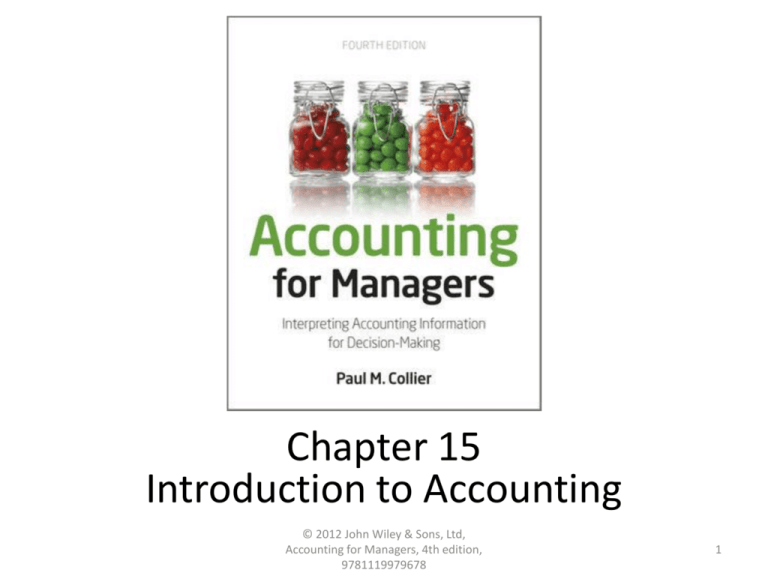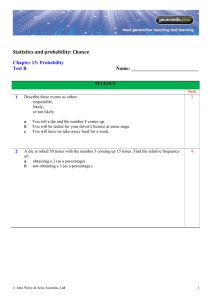Ch.15
advertisement

Chapter 15 Introduction to Accounting © 2012 John Wiley & Sons, Ltd, Accounting for Managers, 4th edition, 9781119979678 1 Overview • Decentralised profit responsibility • Responsibility centres: cost, profit & investment centres • Divisional performance measurement – Absolute profit, ROI & RI methods • • • • Controllable profit Transfer pricing Transaction cost economics Critical perspective © 2012 John Wiley & Sons, Ltd, Accounting for Managers, 4th edition, 9781119979678 2 Structure of organizations • Structure follows strategy – Chandler (1962) • Diversification leads to multi-divisional forms – Galbraith & Nathanson (1976) • ‘the formal allocation of work roles and the administrative mechanisms to control and integrate work activities’ – Child (1972) © 2012 John Wiley & Sons, Ltd, Accounting for Managers, 4th edition, 9781119979678 3 Alternative business structures Fig 15.1 Functional organization chart Fig 15.2 Divisional organization chart © 2012 John Wiley & Sons, Ltd, Accounting for Managers, 4th edition, 9781119979678 4 Responsibility centres • Cost centre – No income generation responsibility – Managed by ability to operate within cost budget • Profit centre – Responsible for ‘bottom line’ profits – Cost budget may be exceeded if it results in higher profits (higher sales, higher margin, etc.) • Investment centre – Responsible for ROI – contribution to corporate ROI – Control of profits and level of investment © 2012 John Wiley & Sons, Ltd, Accounting for Managers, 4th edition, 9781119979678 5 Divisionalisation • Decentralization – devolution of authority to make decisions • Divisionalization – Decentralisation plus delegated profit responsibility – Allows diversification with strategic direction & control – Shareholder value is the criteria for overall business success, but divisional performance is the criteria for divisional success – Managerial responsibility, linked to rewards © 2012 John Wiley & Sons, Ltd, Accounting for Managers, 4th edition, 9781119979678 6 Purposes of reporting divisional performance • To guide divisional managers in making decisions To guide top management in making decisions To enable top management to appraise the performance of divisional management • • – Solomons (1965) © 2012 John Wiley & Sons, Ltd, Accounting for Managers, 4th edition, 9781119979678 7 Methods of divisional performance measurement • Absolute profit • Return on Investment (ROI) • Residual income (RI) © 2012 John Wiley & Sons, Ltd, Accounting for Managers, 4th edition, 9781119979678 8 Absolute profit • Absolute profit: trend, comparison against target, benchmark • Comparing £ profits does not consider the investment in the business and how long-term profits can be affected by short-term decisions © 2012 John Wiley & Sons, Ltd, Accounting for Managers, 4th edition, 9781119979678 9 Return on investment (ROI) • rate of return achieved on the capital employed Div A Div B Capital invested €1,000,000 €2,000,000 Operating profit €200,000 €300,000 Return on investment 20% © 2012 John Wiley & Sons, Ltd, Accounting for Managers, 4th edition, 9781119979678 15% 10 Residual income (RI) • the profit remaining after deducting the notional cost of capital from the investment in the division Div A Div B Capital invested €1,000,000 €2,000,000 Operating profit €200,000 €300,000 less cost of capital at 17.5% €175,000 €350,000 Residual income €25,000 © 2012 John Wiley & Sons, Ltd, Accounting for Managers, 4th edition, 9781119979678 -€50,000 11 Comparison of techniques • ROI – a decision cannot be made about relative performance unless we know the cost of capital • Solomons (1965) • RI – the aim of managers should be to maximise the residual income from the capital investments in their divisions © 2012 John Wiley & Sons, Ltd, Accounting for Managers, 4th edition, 9781119979678 12 Comparison of techniques • Residual income – ‘overcame one of the dysfunctional aspects of the ROI measure in which managers could increase their reported ROI by rejecting investments that yielded returns in excess of their firm’s (or division’s) cost of capital, but that were below their current average ROI’ – Johnson & Kaplan (1987) © 2012 John Wiley & Sons, Ltd, Accounting for Managers, 4th edition, 9781119979678 13 Illustration © 2012 John Wiley & Sons, Ltd, Accounting for Managers, 4th edition, 9781119979678 14 Illustration cont. - ROI © 2012 John Wiley & Sons, Ltd, Accounting for Managers, 4th edition, 9781119979678 15 Illustration cont. - ROI • Division A may not want its project to be approved as its overall ROI will fall from 25% to 24% • Division B may want its project to be approved as its overall RPI will increase from 10% to 10.1% • Corporate view is to prefer Division A investment as it earns a higher ROI © 2012 John Wiley & Sons, Ltd, Accounting for Managers, 4th edition, 9781119979678 16 Illustration cont. - RI © 2012 John Wiley & Sons, Ltd, Accounting for Managers, 4th edition, 9781119979678 17 Illustration cont. - RI • Under the residual income method, Division A’s project would be approved as it contributes to shareholder value, whereas Division B’s project erodes shareholder value – Compare the cost of capital of 15% to Division B’s ROI (13% on new investment) © 2012 John Wiley & Sons, Ltd, Accounting for Managers, 4th edition, 9781119979678 18 Controllability • One of the main problems in evaluating divisional performance is the extent to which managers can exercise control over investments and costs charged to their responsibility centres – ‘individuals should he held accountable only for results they can control’ – Merchant (1987) • Controllable profit – The profit after deducting expenses that can be controlled by the divisional manager, but ignoring those expenses that are outside the divisional manager’s control © 2012 John Wiley & Sons, Ltd, Accounting for Managers, 4th edition, 9781119979678 19 Divisional profit report & controllable profits – Solomons (1965) Sales Less 1,000,000 Variable cost of goods sold 200,000 Other variable expenses 100,000 300,000 Contribution margin 700,000 Less 250,000 Controllable divisional overhead Controllable profit 450,000 Less 175,000 Non-controllable overhead Operating Profit 275,000 © 2012 John Wiley & Sons, Ltd, Accounting for Managers, 4th edition, 9781119979678 Manager accountable for Divisional performance 20 Transfer pricing • What price to charge for in-company transactions? affects the profitability of each business unit – Market price to external customers, including a normal (or lower) profit margin; – Total cost of producing the goods or services, including fixed and variable costs, but excluding any profit margin; – Marginal cost of producing the goods or services, i.e. including only variable costs, with or without a profit margin; – Negotiated price © 2012 John Wiley & Sons, Ltd, Accounting for Managers, 4th edition, 9781119979678 21 The transfer pricing problem • Transfer prices that are suitable for evaluating divisional performance may lead to divisions acting contrary to the corporate interest – Solomons (1965) • Rewarding divisional performance which is not in the best corporate interests – What is good for a single division may not be the best for the organisation as a whole. © 2012 John Wiley & Sons, Ltd, Accounting for Managers, 4th edition, 9781119979678 22 Transfer pricing illustration © 2012 John Wiley & Sons, Ltd, Accounting for Managers, 4th edition, 9781119979678 23 Transfer pricing illustration © 2012 John Wiley & Sons, Ltd, Accounting for Managers, 4th edition, 9781119979678 24 Transaction cost economics • Considers why some activities which require coordination occur within the organization’s hierarchy (i.e. within the corporate structure) while others take place through exchanges outside the organization in the wider market (i.e. between arms-length buyers and sellers) • Whether markets or hierarchies are more cost effective – Outsourcing versus divisionalisation Williamson (1975) © 2012 John Wiley & Sons, Ltd, Accounting for Managers, 4th edition, 9781119979678 25 Transaction costs • Transactions incur costs over and above the price for the commodity bought or sold – Negotiation, monitoring, administration, insurance – Time commitments, obligations – Legal, moral and power conditions © 2012 John Wiley & Sons, Ltd, Accounting for Managers, 4th edition, 9781119979678 26 Critical perspective • Divisional or corporate perspective: • ‘the image of an organisation which is given through Accounts will be from a particular point of view, at a particular point in time and will be selective in its focus’ • Roberts & Scapens (1985) • Managers are often critical that the corporate head office fails to adequately distinguish between controllable and non-controllable overhead © 2012 John Wiley & Sons, Ltd, Accounting for Managers, 4th edition, 9781119979678 27 Critical perspective (cont.) • Determining a risk-adjusted cost of capital for RI purposes can be a subjective exercise • Transfer pricing is subjective and affected by power relations within an organization © 2012 John Wiley & Sons, Ltd, Accounting for Managers, 4th edition, 9781119979678 28 Key points • Decentralised profit responsibility through cost centres, profit centres & investment centres • Divisional performance measurement – Absolute profit, ROI & RI methods • Controllable profit – Managerial accountability and divisional performance • Transfer pricing • Transaction cost economics: markets or hierarchy? • Critical perspective © 2012 John Wiley & Sons, Ltd, Accounting for Managers, 4th edition, 9781119979678 29





